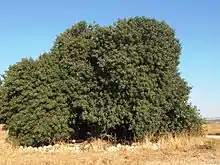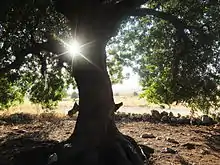Pistacia atlantica
Pistacia atlantica is a species of pistachio tree known by the English common name Mt. Atlas mastic tree[2] and as the Persian turpentine tree.[3] Pistacia ranges from shrubs to trees adapted to drought and the Mediterranean climate. P. atlantica has three subspecies or varieties which have been described as cabulica, kurdica, and mutica.
| Pistacia atlantica | |
|---|---|
.JPG.webp) | |
| Scientific classification | |
| Kingdom: | Plantae |
| Clade: | Tracheophytes |
| Clade: | Angiosperms |
| Clade: | Eudicots |
| Clade: | Rosids |
| Order: | Sapindales |
| Family: | Anacardiaceae |
| Genus: | Pistacia |
| Species: | P. atlantica |
| Binomial name | |
| Pistacia atlantica | |
| Synonyms[1] | |
| |
Names
In Iran it is called baneh or wild pistachio tree.[4] In Tamazight, it is known as Tijjeɣt. In the Canary Islands it is known as Almacigo, and in Arabic, it is called بطم (buṭm or buṭum). In southern Iran, in Bandar-Abbas in Hormozgān Province it is called kasoudang and in Bushehr it is called kolkhong. In Turkey it is commonly known as melengiç. In Kurdish the tree is called darwan or daraban, and the seed is called qezwan (قەزوان). In Pashto it is called Shanna.And in Balochi it is called Gowan.
Description

Pistacia atlantica is a deciduous tree growing up to 7 m (23 ft) tall with branches spreading and growing erect to form a dense crown. The trunk is stout and covered in fissured bark. Old trees may have trunks measuring 2 m (6 ft 7 in) in diameter; it may take 200 years for a tree to reach 1 m (3 ft 3 in) wide.[4] The leaves are pinnate, each with seven to 9 lance-shaped leaflets.
The leaves and branches often have galls when the tree is infested with gall-producing species of aphids, including Pemphigus utricularis,[5] Slavum wertheimae, and Forda riccobonii.[6]
The tree is dioecious with male and female trees producing different types of flowers. Both types are small and greenish and fall away quickly. Monoecious and hermaphrodite trees have been seen, but are unusual.[7] The oblong, fleshy, oily fruit borne by the female tree is 6 to 8 mm (0.24 to 0.31 in) long and pink in color, ripening to blue. It grows slowly, and can reach 1000 years old. It has broken bark with ashen gray color. Older branches have the same design, fractured and ash color, which gives the tree a grizzled look. The leaves are oval, almost sessile, shining above, and dark green, with seven to 9 leaflets, imparipinnate with petioles a little winged, flowers in racemes lax, the male and female on different trees.
The flowers are unisexual, small, discreet green, thick as pea fruit, then changing to reddish blue.[8] In colder areas the leaves in May check and fall in November. Though dioecious, in some communities males dominate the female specimens in number. It grows in oak woodlands and oak sclerophyllus. The fruits ripen from July to October, starting to bear fruit at the age of eight to 10 years, with abundant fruit after two to three years.
Distribution
It is native to a section of Eurasia from North Africa to the Iranian Plateau, where it was once common.[5] Because other trees were rare, it was the only good source of wood and was overharvested, reducing its current distribution.[5] It is a common tree in mountain forests in Iran,[5] and it is "characteristic" of the landscape in parts of Algeria outside the Sahara.[9]
The almacigo is a tree that extends from the North Africa and found in thermophilous forests, up to 600 m altitude. It is one of the few deciduous species native to the Canary archipelago. It is native of Eurasia, the Iranian Plateau, to northern Africa.[5] Azerbaijan (Soltanbud forest)
Uses

There are many uses for this plant. This wild pistachio is the most economically important tree in many parts of Iran, including the Zagros Mountains, where it is managed as a valuable forest tree.[4] The resin and fruit oil were historically used for a variety of medicinal purposes.[5] The resin, known in Iran as saqez, is still an important commodity.[4]
An important use is to combat soil erosion. It strengthens the soil, and is used for reforestation of arid and steep slopes and against landslides. It is stronger than Pistacia terebinthus, where it is used as rootstock in Ukraine and the United States for growing Pistacia vera, but resists frost better than P. Terebinthus.
The resin is used to manufacture alcohol and lacquer. Its essential oils are used in perfume industry. The leaves are rich in tannins, up to 20% in the galls caused by an aphid parasite, used as the raw material for tanning in the leather industry. The sap is dried and used as incense, and its smoke releases a pleasant smell to the local environment for celebrations and religious ceremonies, as "incense". The tannins from the galls were used for tanning.[5]
Food
The pistachio fruits are a food source in the area, but the more commonly cultivated pistachio tree P. vera is more valuable for food production.[4] The seeds, like pistachio, are edible oil seeds, like nuts, and contain up to 60% fat. Candy made with P. atlantica in Turkish are called tsukpi pistachio. Sometimes, the immature fruit is harvested and eaten with sour milk. The plant contains a resin, used as chewing gum in Kevan, Turkey, where it is called kevove rubber tree.
Mastic gum of the tree has been reported to have significant antimicrobial and antifungal activity. Twenty-six compounds in hexane extract were identified. The major compounds were α-pinene 57.06%, β-pinene 9.83%, trans-pinocarveol 2.95%, trans-Verbenol 3.97%, α-Phellandren-8-ol 3.81%.[10] Furthermore, P. atlantica var. kurdica contained several chemical constitutes which have been reported as health benefits. Having a watery flavour, the resin from cultivar P. atlantica kurdica (found in Kurdistan) is used as a chewing gum to relieve upper abdominal discomfort, stomach aches, dyspepsia and peptic ulcer.[11]
It is used in a food in Fars province in Iran, named "OuBanneh" (اوبنه).
The raw fruits of the wild pistachio are not favored as food and are said to taste like turpentine.[12] They are about 45% oil.[9]
Cultivation
Pistacia atlantica is planted as an ornamental shadebearing and drought-tolerant landscape tree in gardens and parks.[13] In California it is imported to use as rootstock for cultivated pistachio trees (Pistacia vera).[14] Both introductions have led to its escape and current status as an occasional invasive species in California.[15]
See also
- Pistacia lentiscus, another species where its mastic is used
References
| Wikimedia Commons has media related to Pistacia atlantica. |
- "The Plant List: A Working List of All Plant Species". Retrieved 21 November 2014.
- "Pistacia atlantica". Natural Resources Conservation Service PLANTS Database. USDA. Retrieved 6 October 2015.
- Investigation of Drought influence on rodent food behavior and destruction of watershed in arid and semi-arid regions
- Pourreza, M., et al. (2008). Sustainability of wild pistachio (Pistacia atlantica Desf.) in Zagros forests, Iran. Forest Ecology and Management 255 3667-71.
- Pistacia atlantica Desf. FAO Fact Sheet
- Martinez, J. J. I. (2008). Impact of a gall-inducing aphid on Pistacia atlantica Desf. trees. Arthropod-Plant Interactions 2:3 147-51.
- İsfendiyaroğlu, M. & E. Özekera. (2009). Inflorescence features of a new exceptional monoecious Pistacia atlantica Desf. (Anacardiaceae) population in the Barbaros Plain of İzmir/Turkey. Archived 2011-07-22 at the Wayback Machine International Journal of Plant Production 3:3.
- Ozenda, P. (1991). Flore et Végétation du Sahara. París:CNRS. ISBN 2-271-06230-6.
- Yousfi, M., et al. (2002). Letter to the Editor: Fatty acids and sterols of Pistacia atlantica fruit oil. Journal of the American Oil Chemists' Society 79:10 1049-50.
- Amhamdi, H., Aouinti, F., Wathelet, J.P. and Elbachiri, A., 2009. Chemical composition of the essential oil of Pistacia lentiscus L. from Eastern Morocco. Records of Natural Products, 3(2), p.90.
- Ahmed, H.M., 2017. Traditional uses of Kurdish medicinal plant Pistacia atlantica subsp. kurdica Zohary in Ranya, Southern Kurdistan. Genetic Resources and Crop Evolution, 64(6), pp.1473-1484.
- Botany Photo of the Day. UBC Botanical Garden.
- University of Arizona CE. Pistacia atlantica
- Jepson Manual Treatment
- LA & San Gabriel River Council. Pistacia atlantica